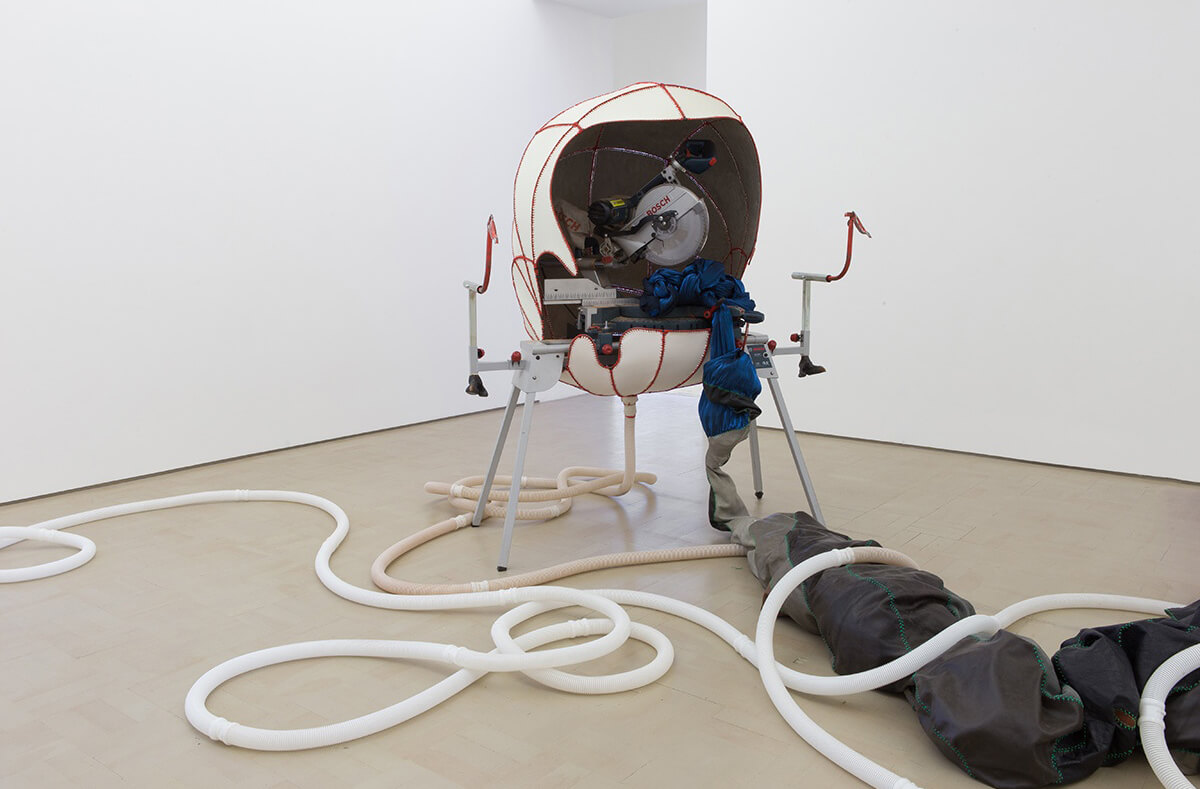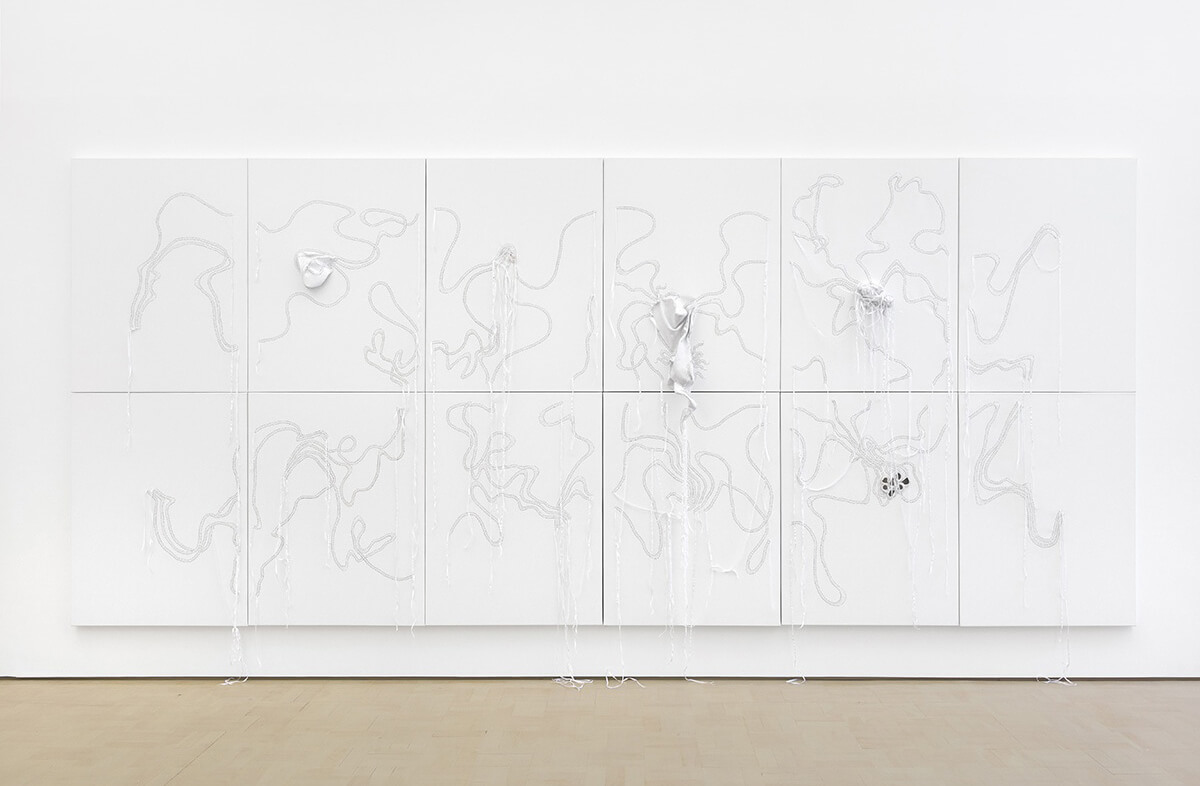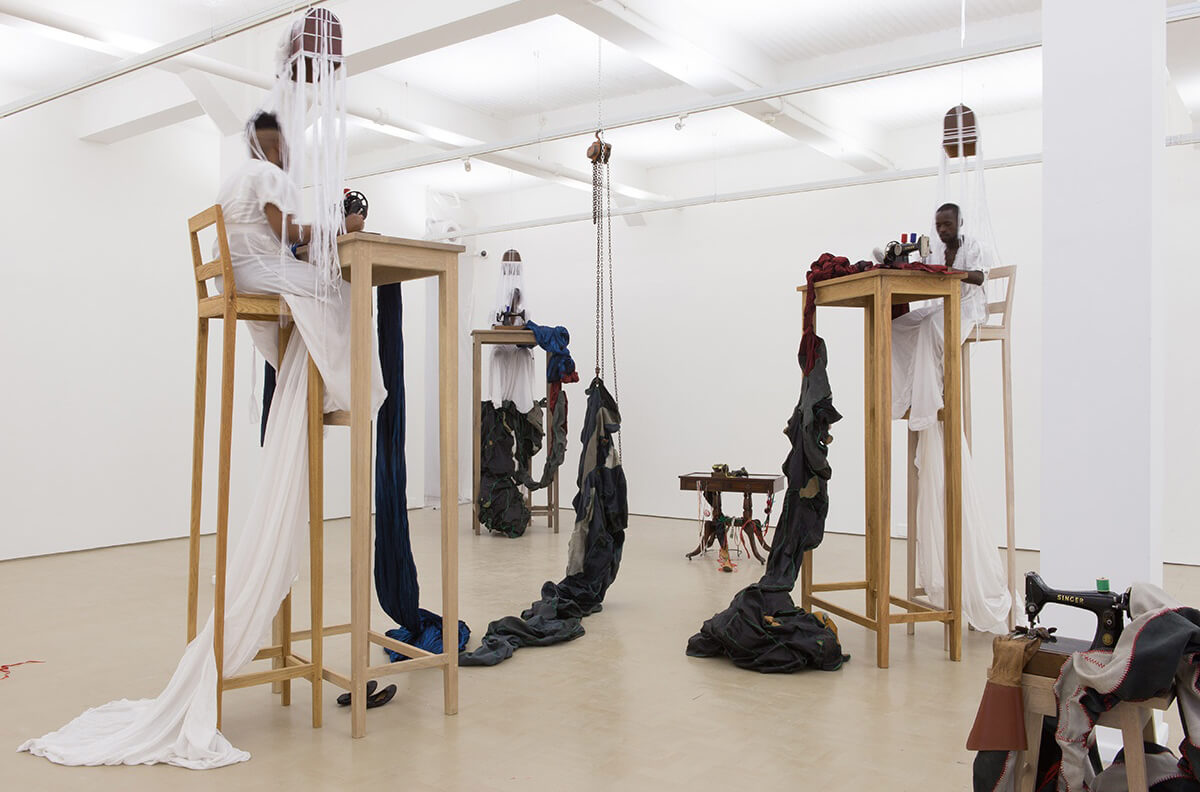On Nicholas Hlobo’s Sewing Saw

‘Intsimbi edlezinye’ (2016) | hacksaw, leather, bronze, steel
It is not typical for Nicholas Hlobo to title his exhibitions in English. His solo exhibition Sewing Saw, his first at Stevenson since the opening of their Woodstock premises in 2009, is in many ways a re-examining. In this offering, Hlobo revisits the origins of his own practice through the materials and processes that gave them shape. Fabric, leather, ribbon, tire tubing, sewn paper – all recurrent features of his repertoire – are exposed as they emerge from the factory floor to their current place in the gallery.
In this revisiting, the organic tire inner tubing sculptures seen in Hlobo’s previous work reappear, this time attached to and in the midst of their sewing. Several sculptural forms are physically tethered in this way. Ribbons ensnare horse shoes. Singer sewing machines remain attached to their fabric. Another work, Uphumlile, molds with what could be a grammar phone, its bell covered entirely in inner tubing.
Other works rupture the surface of paper or canvas in near-monochrome, with white on white, or white on cream with gold ribbon darting through the parchment. Zapalala futhi, Hlobo explained, is “when things overflow out of excitement or pain.” A large-scale work on paper, in Zapalala futhi (2016), these paper punctures are immaculate, while their ribboned forms snake in and out, merging in nebulous, tumour-like forms in white leather.

‘Zophalala Futhi’ (2016) | Ribbon and leather on canvas
Concurrently, this work finds itself in Woodstock, the former heart of the country’s manufacturing industry. For many people of a certain generation, the considerable presence of Singer sewing machines will recall a time and a moment of widespread domestic labour, typically carried out by grandmothers, mothers, aunts, sisters, or perhaps themselves. In the performance umBhovuzo: The Parable of the Sower, four men positioned around the largest exhibition space silently worked with cotton and raw silk, mending continuously whilst perched above the viewer on elongated wooden chairs, seated at equally elongated tables.
On a first read, Hlobo’s decision to include men in the performance umBhovuzo: The Parable of the Sower, shifts these gendered perceptions of sewing in sensitive ways. The gendered dynamics of the scene, and the ideas encompassing umBhovuzo: The Parable of the Sower however, took on another, more complex dimension after hearing about the origins of umBhovuzo. The title Hlobo explained, “is an old and disappeared party where young women and old men would participate in organized orgies, prior to the presence of Christianity.”

‘umBhovuzo: The Parable of the Sower’ (2016)
Describing this as a joyful act, Hlobo likens the practice to the ecclesiastical reference of the Parable of the Sower, a story in which a sower sowed seeds first on rocky ground, yielding no fruit, and then on good ground, yielding abundant crops. As Hlobo elaborated, the physical mechanism of the sewing machine, and the manner in which the needle moves evokes penetration. So too are the sewer and sewing machine enveloped in an intimate scene. In the interplay of sew, sow, and sex, all converge in the possibility of creation and newness.
Other performers embodied a tempered pensiveness, moving slowly and silently, or not at all. A figure draped in white cotton and billowing fabric constructed with wire circular frames walked through the exhibition spaces before gazing perpetually into three circular mirrors, swaying, but never moving from this gaze. Outside this space, three women-appearing performers sat in a row, in black lace and white cotton with Singer boxes encasing their heads. White ribbons edge these ‘helmets’, forming a veil.
In the absence of these physical, breathing bodies, the exhibition takes on another quality. The ‘residue’ of a performance is a common device to allow performative work to endure within gallery or museum settings, and thus the exhibition could be thought of in two phases, or two states of being. The performers’ absence is not a remnant, but a development of the work, which in some distant way, echoes the once fully occupied and lively manufacturing houses on the main road. Behind a wall in the gallery, 24 Million Light Years (2016), 24 circular mechanisms – disassembled ceiling fans – spin and vibrate, generating a low hum likened, one could assume, to the sound of working sewing machines.
As is customary in Hlobo’s work, all titles (with the exception of 24 Million Light Years and the exhibition title) are in isiXhosa. As other writers and art historians have already noted, Hlobo intentionally uses isiXhosa titles to ground the works in Xhosa culture. For outsiders and non-isiXhosa speakers, like myself, one can only begin to understand the contexts that give rise to such works and experiences. Entering into this space, one could assume that there are a significant number of other viewers operating within the art world for whom the understanding of Sewing Saw, or indeed, any other work outside their immediate cultural understanding, is partial. This is revealing in itself, and, as Hlobo discussed, “a reflection on how far we’ve come as a country.”
Obangulwa ngubani xa equlungene kangaka, Hlobo explained, could be understood by the way in which a small splinter can cause swelling, and later, infection, if it is not dealt with: “you must pick it out before it colonizes you.” A work that comprises 12 canvas panels, Obangulwa ngubani xa equlungene kangaka (2016), like the work on paper Zapalala futhi, this composition is a serene ground of interweaving and intersecting sewn tracks interrupted and converging in sickly porous ruptures, or bulging leather sacs. As a remedy for prolonged pain, “pick it out before it colonizes” is a readily applicable statement both personally and politically.
Owing to the great expanse of Hlobo’s vision, Sewing Saw is intellectually and visually generous. Hlobo directly links the presence of the exposed mechanical process to the organic functioning and disfunction of the human body. Here, bodily desires mingle with a need to approach the tested from a new angle. These efforts combine in a sumptuous fashion, confirming yet again Hlobo’s conceptual and material brilliance.

‘Umbhexeshi’ (2016) | Wood, leather, ribbon, singer sewing machine, gloves